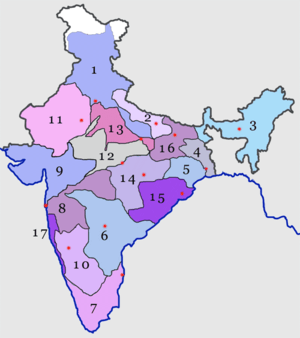Eastern Railway zone
 | |
 4-Eastern Railway | |
 | |
| Locale | West Bengal and Jharkhand, South West Bihar |
|---|---|
| Dates of operation | April 14, 1952– |
| Predecessor | East Indian Railway |
| Track gauge | Mixed |
| Electrification | 1,501 kilometres (933 mi) |
| Length | 2,680 kilometres (1,670 mi) |
| Headquarters | Fairley Place, Kolkata |
| Website | ER official website |
The Eastern Railway (abbreviated ER and পূর্ব, पूरे / पूर्व) is among the 16 zones of the Indian Railways. Its headquarters is at Fairley Place, Kolkata and comprises four divisions: Howrah, Malda, Sealdah, and Asansol. Each division is headed by a Divisional Railway Manager (DRM). The name of the division denotes the name of the city where the divisional headquarters is located. Eastern Railway Consists Most no. of A1 and A Category Stations like Howrah, Sealdah, Bhagalpur, Asansol, Durgapur etc. Eastern Railways operates one of the oldest trains of India, Kalka Mail. 3 Popular Zones ECR, SER and NFR were part of ER before.
It has three major workshops: Jamalpur, Liluah, and Kanchrapara. The Jamalpur Workshop is for wagon repair, periodic overhaul (POH) of diesel locomotives, manufacturing of cranes and tower-wagons; the Liluah workshop is for POH of coaching & freight vehicles and the Kanchrapara Workshop is for POH of electric locomotives, EMU Locals and coaches.
History
The East Indian Railway (EIR) Company was incorporated in 1845 to connect East India with Delhi. The first train ran here between Howrah and Hooghly on 15 August 1854. The train left Howrah Station at 8:30 a.m. and reached Hooghly in 91 minutes. The management of the East Indian Railway was taken over by the British Indian government on 1 January 1925.[1]
The Eastern Railway was formed on 14 April 1952 by amalgamating three lower divisions of the East Indian Railway: Howrah, Asansol and Danapur, the entire Bengal Nagpur Railway (BNR) and the Sealdah division of the erstwhile Bengal Assam Railway[2] (which was already added to the East Indian Railway on 15 August 1947). On 1 August 1955, the portions of BNR stretching from Howrah to Visakhapatnam in the South, Howrah to Nagpur in the Central area and up to Katni in the North Central Region were separated from Eastern Railway and became the South Eastern Railway.[3][4] Three more divisions: Dhanbad, Mughalsarai and Malda were formed later.[5] Till 30 September 2002 ER consisted seven divisions.
On 1 October 2002 a new zone, the East Central Railway, headquarters at Hajipur, was carved out by separating the Eastern Railway's Danapur, Dhanbad and Mughalsarai divisions from it.[4] Presently, it comprises four divisions and they are Malda Town, Howrah, Sealdah and Asansol.
On November 28, 2017, Eastern Railways brought into service, the first rake of upgraded Sealdah – New Delhi ‘Swarna’ Rajdhani. This rake has become India’s first Swarna Rajdhani rake under Project ‘Swarna’ of Indian Railways. Under Project ‘Swarna’, Indian Railways had given a free hand to Zonal Railways to develop and create aesthetic and passenger friendly coach interiors on running rakes of Rajdhani and Shatabdi trains.
The objective was to establish new standards in passengers comfort. A budget of Rs. 50 lakh per rake was allocated for this purpose. The first rake of Sealdah – New Delhi Rajdhani has been upgraded at an expenditure of about Rs. 35 lakh. The new features in the coach are aesthetic International colour scheme and LED lighting to improve illumination, night signage for easy identifications of berth numbers, better hygiene by providing ‘auto janitor’ system in toilets, built-in ladders adjacent to berths for easy access to upper berth and CCTV cameras in doorway area and aisles to monitor any suspicious activity.
Routes


Trunk routes
- Howrah-Delhi Main Line[Electrified BG line]
- Grand Chord[Electrified BG line]
- Sahibganj Loop[Electrified BG line till Pakur, rest under electrification]
Sub Urban Section
- Sealdah-Ranaghat-Krishnanagar-Berhampore-Lalgola Line
- Howrah-Bardhaman Main Line of Howrah-Delhi Main Line
- Bandel-Katwa
- Sheoraphuli – Tarakeswar – Arambagh Branch Line
- Howrah-Bardhaman Chord of Howrah-Delhi Main Line
- Barharwa-Azimganj-Khagraghat Road-Katwa Loop Line
- Jasidih Dumka Rampurhat Rail line
- Bardhaman-Asansol section of Howrah-Delhi Grand Chord Line
- Khana-Barharwa section of Sahibganj Loop
- Lalgola and Gede branch lines
- Andal-Sainthia Branch Line
- Sealdah-Ranaghat Line
- Ranaghat - Shantipur - Krishnanagar City
- Howrah-Belur Math
- Sealdah-Barasat-Bangaon-Ranaghat Line
- Barasat - Hasnabad Branch Single Line
- Dum Dum - Biman Bandar (Discontinued)
- Sealdah - Baruipur - Diamond Harbour of Sealdah South Lines
- Sonarpur - Canning of Sealdah South Lines
- Baruipur - Lakshmikantapur - Namkhana of Sealdah South Lines
- Sealdah - Budge Budge of Sealdah South Lines
- Kolkata Circular Railway
- Ahmedpur Katwa Railway
- Burdwan Katwa Railway
See also
References
- ↑ Rao, M.A. (1988). Indian Railways, New Delhi: National Book Trust, pp.13,34
- ↑ "Sealdah division-Engineering details". The Eastern Railway, Sealdah division. Archived from the original on 15 February 2012.
- ↑ Rao, M.A. (1988). Indian Railways, New Delhi: National Book Trust, pp.42–3
- 1 2 "The Eastern Railway-About us". The Eastern Railway. Archived from the original on 14 September 2008.
- ↑ "Focus-Eastern Railway". Press Information Bureau, Government of India.